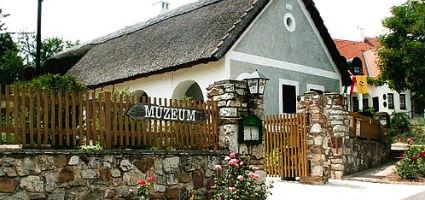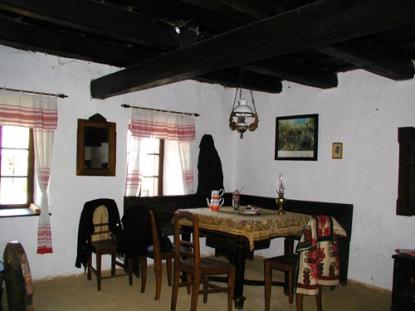2024. April 24. Wednesday
Region house - Paloznak
 |
Address: 8229, Paloznak Fő u. 6.
Phone number: (87) 555-006
E-mail: info@paloznak.hu
Opening hours: *26.06-26.08.: Tue-Sun 9-12, 16-20
|
Museum tickets, service costs:
|
Ticket for adults
|
150 HUF
|
|
|
Group ticket for adults
(over 20 people)
|
80 HUF
|
/ capita
|
|
Ticket for students
|
80 HUF
|
|
|
Ticket for pensioners
|
80 HUF
|
The house has an arched ceiling while the hallway is narrow. The kitchen does not belong to the traditional 'smoky kitchen' type but has a free chimney in it. We can enter the 'clean room' from the hallway, which is unusually spacey. At least two generations occupied the clean room. The room is a typical peasant room of the Upper Balaton area. Chairs surround the corner bench that stands in the corner with a table in front of it. There are two beds, a cupboard, and a chest with tulip pattern in the room as well. Next to the stove, the armed chair stands which the head of the family could occupy only. The green stove, so typical of the area and the Bakony area can also be found in this room.

The ornamentation, the pictures on the walls, the textiles follow the traditions of the peasant families. The tools and objects are placed to their original positions. The so-called 'wall teka' with its wooden door is of a special interest. The valuables of the family were kept in it.
Only a few furniture and the most necessary belongings were placed in the kitchen. Most of the objects were hung on the walls and placed on benches. The top of the furnace was full of tools and equipments. The tools of bread baking were placed nest to the back wall.
The kitchen was separated from the porch by a lintel where plates and different pottery were kept as ornamentation. The water bench is at the entrance of the chamber with dishes on. The basin stand is a modern object. Over it, a wall cover is placed with inscriptions of educational value.
The chamber served two purposes: partly the equipments of farming were stored there; partly it served as a room for sleeping if needed. Opposite to the door the 'dikó', the bed stood. Among the equipments, those that were rarely used were stored in the chamber. Some of the food, like bacon, grease was also stored there as well as the equipments of washing.
The cellar was not a wine cellar. Wine cellars were located at the hills. Only the richest peasants and the poorest that did not have a wine cellar kept wine at their houses. The cellars at the houses served to store tools and equipments of farming.
György Lovas

The ornamentation, the pictures on the walls, the textiles follow the traditions of the peasant families. The tools and objects are placed to their original positions. The so-called 'wall teka' with its wooden door is of a special interest. The valuables of the family were kept in it.
Only a few furniture and the most necessary belongings were placed in the kitchen. Most of the objects were hung on the walls and placed on benches. The top of the furnace was full of tools and equipments. The tools of bread baking were placed nest to the back wall.
The kitchen was separated from the porch by a lintel where plates and different pottery were kept as ornamentation. The water bench is at the entrance of the chamber with dishes on. The basin stand is a modern object. Over it, a wall cover is placed with inscriptions of educational value.
The chamber served two purposes: partly the equipments of farming were stored there; partly it served as a room for sleeping if needed. Opposite to the door the 'dikó', the bed stood. Among the equipments, those that were rarely used were stored in the chamber. Some of the food, like bacon, grease was also stored there as well as the equipments of washing.
The cellar was not a wine cellar. Wine cellars were located at the hills. Only the richest peasants and the poorest that did not have a wine cellar kept wine at their houses. The cellars at the houses served to store tools and equipments of farming.
György Lovas
